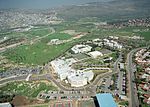Beit HaKerem Valley
Israel geography stubsValleys of Israel
Beit HaKerem Valley (Hebrew: בקעת בית כרם), also known as al-Shaghur (Arabic: الشاغور, romanized: al-Shāghūr), is a valley in the Galilee region in northern Israel. The valley is the dividing feature between the Upper Galilee featuring relatively high mountains and the Lower Galilee to the south, with lower mountains.The five Arab local authorities (Bi'ina, Deir al-Asad, Majd al-Krum, Nahf and Rameh) and two Jewish local authorities (Karmiel and Misgav) of the Beit HaKerem Valley have formed a "cluster" of municipalities, connecting municipal leaders to create long-term development strategies, enhance economic development, and attract and receive additional government funding.
Excerpt from the Wikipedia article Beit HaKerem Valley (License: CC BY-SA 3.0, Authors).Beit HaKerem Valley
Nahf
Geographical coordinates (GPS) Address Nearby Places Show on map
Geographical coordinates (GPS)
| Latitude | Longitude |
|---|---|
| N 32.9287 ° | E 35.3028 ° |
Address
2196024 Nahf
North District, Israel
Open on Google Maps









